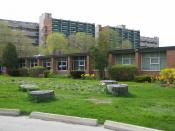Part 1:
1. "Experiential education is a philosophy and methodology in which educators purposefully engage with learners in direct experience and focused reflection in order to increase knowledge, develop skills and clarify values." (aee.org) incorporating Experiential Education into the classroom is very beneficial to both the student and the teacher. Since some students do not learn as well in the classroom setting, experiential education will allow those students to understand the material covered outside of the classroom setting. Another reason experiential education is a benefit to students is through physical activity. I know from personal experience that I am not a great learner in a classroom environment. That is why I like to do physical activities, they are not boring like lectures, students are forced to stay awake and participate, and not just one person is singled out. A school that has integrated experiential education into their curriculum is the Belfast Academy in Goldsboro, North Carolina. This schools mission is to "The mission of Belfast Academy guarantees students will exude attitude, effort, and attendance. This will be accomplished by providing an integrated curriculum delivered by an innovative staff in a multipurpose environment." This school takes the students on more trips and involves them more then a regular public school. The students actually learn more and better. In conclusion, experiential education exists only as an added style of learning that is beneficial to all different types of students.
Part 2:
1. See attached sheet
2. Connecting Subjects:
a. English - Information Skills- English can be linked with Information skills through research. Information skills can be used to find research on a specific topic. English can be used to comprehend the information and write a paper based on it.
b. Science - Social Sciences- Science can be linked with Social Sciences in geography. Science can be used to determine what the specific fossils, artifacts, and rocks are. Social Science can be used to find the uses of the artifacts and find the time period in which the material is from.
c. Science - Information Skills - Mathematics - English- Science and math can be linked through data analysis. Science can be used to create and test a hypothesis. Information Skills can be used to gather the information during testing. Math can be used to create graphs, and tables on the information gathered. English can be used to type up the lab report and conclusion.
d. Social Sciences - Mathematics - Information Skills- Social Sciences and math can be linked together in geography. Social Science can be used to study significant geographical locations. Math is used to study the land around the site and the site in general. (Topography, building structures, and elevation.) Information Skills can be used to collect and understand the gathered information.
e. Health - Dance - English- Health and Dance can be linked through physical exercise and personal fitness. Health can be used to create a personal workout plan or diet program. Dance can be used to incorporate physical activities to a workout plan or a diet program. English can be used to create a plan to stay healthy.
3. there are many different activities that can be used to connect several classes:
a. English - Information Skills- an activity that can be used to connect theses two classes is a research paper on a local historical place. The students can do research on the place and then take a field trip to see how life was, or how the place works. Then they could write the paper on its history and how it has affected them.
b. Science - Social Sciences- an activity that can be used to connect the two classes is an archeological dig. The students can travel to a local dig site and do their own dig to see if they can find any fossils, or artifacts. They can then write up a lab report or a paper on the objects they find.
c. Science - Mathematics - Information Skills - English- these classes can be connected through an activity in the form of a science lab on marine mammals. The students could research several marine mammals and make graphs showing population over the years and industrial growth. Then English can be used to write up the lab report.
d. Social Sciences - Mathematics - Information Skills- these classes can be connected through an activity based on topography. They can take a trip to a local park and participate in a guided hike, using compasses and maps. Then they can use Information Skills to write a paper on geography.
e. Health - Dance- Health and dance can be connected through a musical. Students can put on a play for the school. The Health teacher can talk to the students about being healthy and why performing in the play can benefit their health. The Dance instructor can then create steps to the play.
4. Multiple Intelligences:
a. English - Information Skills- the multiple intelligences used are Visual/Spatial, Intrapersonal Intelligence, Naturalist, and Interpersonal.
b. Science - Social Sciences- the multiple intelligences used are
c. Science - Mathematics - Information Skills - English- the multiple intelligences used are Visual/Spatial, Logical/Mathematical, Verbal/Linguistic, and Body/Kinesthetic.
d. Social Sciences - Mathematics - Information Skills- the multiple intelligences used are Visual/Spatial, Logical/Mathematical, Verbal/Linguistic, Naturalistic, Intrapersonal, and Body/Kinesthetic.
e. Health - Dance- the multiple intelligences used are Body/Kinesthetic, Interpersonal, and Musical/Rhythmic.



Wilderness Leadership, Experiential Education: Case Study.
I couldn't agree with you more with experiential education.
Great write up
0 out of 0 people found this comment useful.